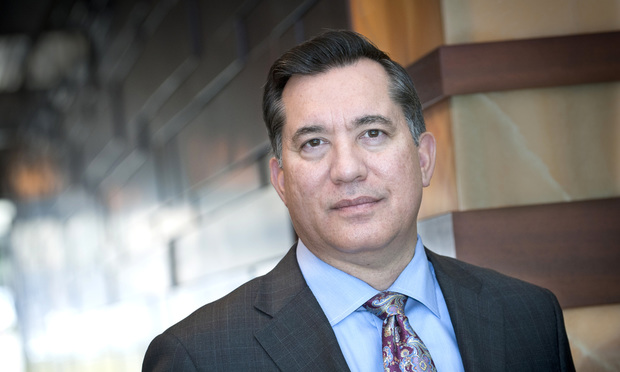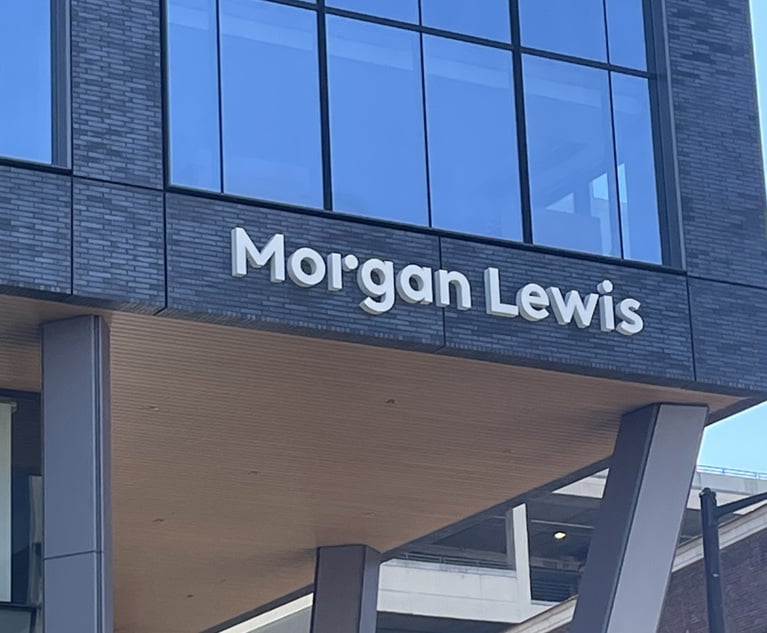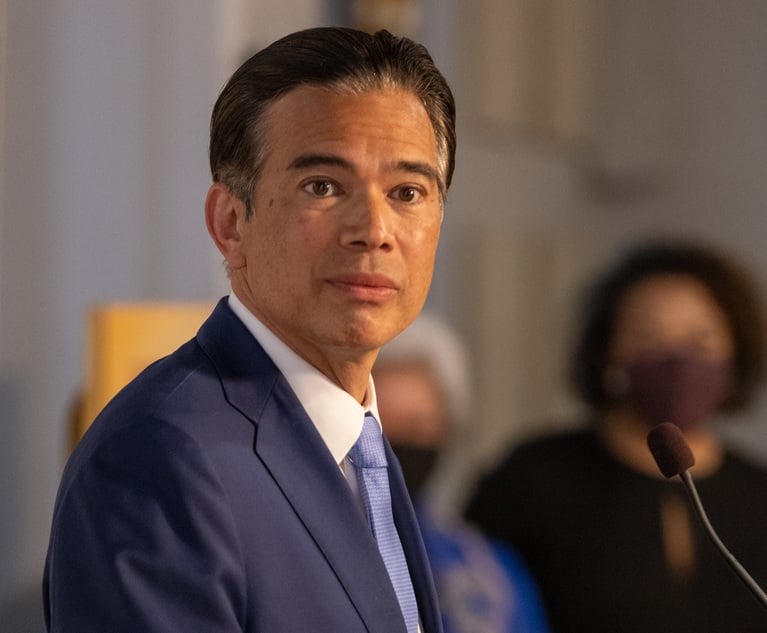Calif. Judge, in First-of-Its-Kind Ruling, Sets FRAND Rate on Ericsson Patent Portfolio
In a win for Sheppard Mullin partner Stephen Korniczky, a federal judge more than halved the rates the Swedish telecom was seeking from China's TCL Communication to license patents that are essential to implementing the 2G, 3G and 4G cellular communication standards.
December 22, 2017 at 05:19 PM
7 minute read

U.S. District Judge James Selna of the Central District of California has concluded a mammoth trial over FRAND royalties by more than halving the rates Swedish telecom Ericsson was seeking from China's TCL Communication, the world's seventh largest smartphone maker.
Selna's 115-page opinion follows a February bench trial that was monitored by prominent IP lawyers with clients in the wireless industry. Along with saving TCL tens of millions in royalties, TCL v. Ericsson also represents the first time a U.S. judge has set a fair, reasonable and non-discriminatory (FRAND) royalty rate on an entire portfolio of standard-essential patents (SEPs).
At issue are about 100 to 150 Ericsson patents that are essential to implementing the 2G, 3G and 4G cellular communication standards. Ericsson and other wireless innovators committed to the European Telecommunications Standards Institute (ETSI) that they would license their patents on FRAND terms in exchange for being part of the standard.
➤➤ Get IP news and commentary straight to your in-box with Scott Graham's email briefing, Skilled in the Art. Learn more and sign up here.
Ericsson has licensed numerous other smartphone makers, but TCL, which markets phones under its own name and the Alcatel and BlackBerry brands, has refused to pay since 2007. TCL complained that Ericsson was discriminating by charging the higher rate paid by regional smartphone makers such as Karbonn Mobiles in India and Coolpad in China, even as TCL has become a global player.
TCL wanted the lower rates charged to behemoths like Apple Inc. and Samsung Electronics Co., and it particularly objected to the $2 floor Ericsson wanted to impose on each unit of TCL sales. Ericsson argued that Apple and Samsung aren't similarly situated because their smartphones sell for hundreds of dollars more on average than TCL's. At trial Ericsson argued it needed the floor because TCL sometimes gives away its phones for free or close to it, making a percentage royalty nearly worthless.
Selna ruled in a decision made public Friday that while Ericsson had not acted in bad faith, its offers to TCL were “radically divergent” from the rates it accepted from similarly situated licensees—including Apple and Samsung. “Ericsson would clearly prefer that Apple and Samsung be considered sui generis” Selna wrote, “but the prohibition on discrimination would mean very little if the largest, most profitable firms could always be a category unto themselves simply because they were the largest and most profitable firms.”
Selna did agree with Ericsson that some amount of discrimination among licensees is permissible. “There is no single rate that is necessarily FRAND,” he wrote. But Ericsson's offers to TCL were far enough out of line to hurt its ability to compete. That was all TCL had to prove—not antitrust-style harm to the market as a whole, as Ericsson had argued. “The Sherman Act and its long history provide no guide to understanding ETSI's non-discrimination under FRAND,” Selna concluded.
He set a FRAND 4G rate at 0.45 percent of TCL's U.S. sales and 0.31 percent for overseas sales. Ericsson had been looking for an effective rate of between 0.87 and 1.01 percent based on its two best offers before TCL sued in 2014. Selna also ordered TCL to pay Ericsson $16.4 million for past unlicensed sales from 2007 through 2014, much less than the $97 million Ericsson had been seeking.
TCL was represented by Sheppard, Mullin, Richter & Hampton. Partners Stephen Korniczky, Martin Bader and Matthew Holder led Sheppard's trial team. Ericsson was represented by McKool Smith and Crowell & Moring.
Korniczky said Friday the ruling will save his client tens and possibly hundreds of millions of dollars over the term of the license.
“This case demonstrates the need for transparency in order to level the playing field in an SEP portfolio license negotiation,” Korniczky said. Ericsson had originally spoke of holding 40,000 essential patents. But after Selna ordered the company to produce a list with claim charts, the Sheppard team was ultimately able to show the number was far smaller. “When all was said and done, we were really fighting over about 150 patent families,” he said.
Ericsson did not immediately reply to a message left with its press office Friday.
Ericsson also was undone in part by its own press releases. As early as 2002 the company joined Nokia, Siemens and others in announcing that they foresaw an aggregate royalty for the 3G standard at “the modest single-digit level.” Similarly in 2008, the company envisioned a “reasonable maximum aggregate royalty level of 6-8 percent” for 4G handsets.
Those announcements were made at a time when smartphones sold for $500 to $800, whereas now more than half go for less than $150, Ericsson argued. But Selna ruled they were “a pledge to the market” to persuade handset makers to adopt 3G and 4G instead of competing cellular standards.
From there, Selna adopted TCL's “top down” approach—estimating the number of patents actually essential to practicing the 2G, 3G and 4G standards, and Ericsson's share of them. Ericsson had originally claimed 25 percent of the SEPs, but Selna ultimately put the figure between 4 and 7.5 percent.
The top-down method isn't perfect, Selna wrote. But he preferred it to Ericsson's “ex-standard,” in which the value of each standard essential patent—whether it covers faster data speeds, or longer battery life or various other improvements—is estimated independently of its value from being incorporated into a standard. “In the end, the court found that the ex-standard approach lacked fundamental credibility,” Selna wrote.
In deciding which handset makers were similarly situated, Selna emphasized TCL's global reach, as opposed to the regional power of “local kings” such as Coolpad. While TCL “overstates” the plight of a midsized player, excluding Apple, Samsung and other largest players from the analysis “would have the effect of insulating them, and further contributing to their dominant positions, by imposing a barrier in the form of higher rates for those not at the top end of the market,” he wrote.
One of Ericsson's two best offers included a $2 floor and a $4.50 cap on TCL's royalty. TCL had objected vigorously to the floor, and Selna sided with the company on that point. Dollar-per-unit royalties are inconsistent with industry and Ericsson practices, he wrote. On the witness stand, Ericsson's chief IP officer, Lars Gustav Brismark, “explained that its existing caps and floors are solely the product of negotiations, not any sort of analysis of whether they are fair or reasonable,” Selna wrote.
Despite all of the careful “unpacking” of Ericsson licenses Selna performed in the opinion, the judge admitted that precision is impossible. “The court acknowledges that it cannot determine an appropriate FRAND royalty with exactitude,” he wrote. “However, with abundant and largely congruent data before the court, the court finds that 0.45 percent is an appropriate FRAND for Ericsson's 4G SEP portfolio in the United States.”
This content has been archived. It is available through our partners, LexisNexis® and Bloomberg Law.
To view this content, please continue to their sites.
Not a Lexis Subscriber?
Subscribe Now
Not a Bloomberg Law Subscriber?
Subscribe Now
NOT FOR REPRINT
© 2025 ALM Global, LLC, All Rights Reserved. Request academic re-use from www.copyright.com. All other uses, submit a request to [email protected]. For more information visit Asset & Logo Licensing.
You Might Like
View All
Morgan Lewis Shutters Shenzhen Office Less Than Two Years After Launch

Invoking Trump, AG Bonta Reminds Lawyers of Duties to Noncitizens in Plea Dealing
4 minute read
‘Extremely Disturbing’: AI Firms Face Class Action by ‘Taskers’ Exposed to Traumatic Content
5 minute read
State Appeals Court Revives BraunHagey Lawsuit Alleging $4.2M Unlawful Wire to China
3 minute readTrending Stories
- 1'A Death Sentence for TikTok'?: Litigators and Experts Weigh Impact of Potential Ban on Creators and Data Privacy
- 2Bribery Case Against Former Lt. Gov. Brian Benjamin Is Dropped
- 3‘Extremely Disturbing’: AI Firms Face Class Action by ‘Taskers’ Exposed to Traumatic Content
- 4State Appeals Court Revives BraunHagey Lawsuit Alleging $4.2M Unlawful Wire to China
- 5Invoking Trump, AG Bonta Reminds Lawyers of Duties to Noncitizens in Plea Dealing
Who Got The Work
J. Brugh Lower of Gibbons has entered an appearance for industrial equipment supplier Devco Corporation in a pending trademark infringement lawsuit. The suit, accusing the defendant of selling knock-off Graco products, was filed Dec. 18 in New Jersey District Court by Rivkin Radler on behalf of Graco Inc. and Graco Minnesota. The case, assigned to U.S. District Judge Zahid N. Quraishi, is 3:24-cv-11294, Graco Inc. et al v. Devco Corporation.
Who Got The Work
Rebecca Maller-Stein and Kent A. Yalowitz of Arnold & Porter Kaye Scholer have entered their appearances for Hanaco Venture Capital and its executives, Lior Prosor and David Frankel, in a pending securities lawsuit. The action, filed on Dec. 24 in New York Southern District Court by Zell, Aron & Co. on behalf of Goldeneye Advisors, accuses the defendants of negligently and fraudulently managing the plaintiff's $1 million investment. The case, assigned to U.S. District Judge Vernon S. Broderick, is 1:24-cv-09918, Goldeneye Advisors, LLC v. Hanaco Venture Capital, Ltd. et al.
Who Got The Work
Attorneys from A&O Shearman has stepped in as defense counsel for Toronto-Dominion Bank and other defendants in a pending securities class action. The suit, filed Dec. 11 in New York Southern District Court by Bleichmar Fonti & Auld, accuses the defendants of concealing the bank's 'pervasive' deficiencies in regards to its compliance with the Bank Secrecy Act and the quality of its anti-money laundering controls. The case, assigned to U.S. District Judge Arun Subramanian, is 1:24-cv-09445, Gonzalez v. The Toronto-Dominion Bank et al.
Who Got The Work
Crown Castle International, a Pennsylvania company providing shared communications infrastructure, has turned to Luke D. Wolf of Gordon Rees Scully Mansukhani to fend off a pending breach-of-contract lawsuit. The court action, filed Nov. 25 in Michigan Eastern District Court by Hooper Hathaway PC on behalf of The Town Residences LLC, accuses Crown Castle of failing to transfer approximately $30,000 in utility payments from T-Mobile in breach of a roof-top lease and assignment agreement. The case, assigned to U.S. District Judge Susan K. Declercq, is 2:24-cv-13131, The Town Residences LLC v. T-Mobile US, Inc. et al.
Who Got The Work
Wilfred P. Coronato and Daniel M. Schwartz of McCarter & English have stepped in as defense counsel to Electrolux Home Products Inc. in a pending product liability lawsuit. The court action, filed Nov. 26 in New York Eastern District Court by Poulos Lopiccolo PC and Nagel Rice LLP on behalf of David Stern, alleges that the defendant's refrigerators’ drawers and shelving repeatedly break and fall apart within months after purchase. The case, assigned to U.S. District Judge Joan M. Azrack, is 2:24-cv-08204, Stern v. Electrolux Home Products, Inc.
Featured Firms
Law Offices of Gary Martin Hays & Associates, P.C.
(470) 294-1674
Law Offices of Mark E. Salomone
(857) 444-6468
Smith & Hassler
(713) 739-1250






